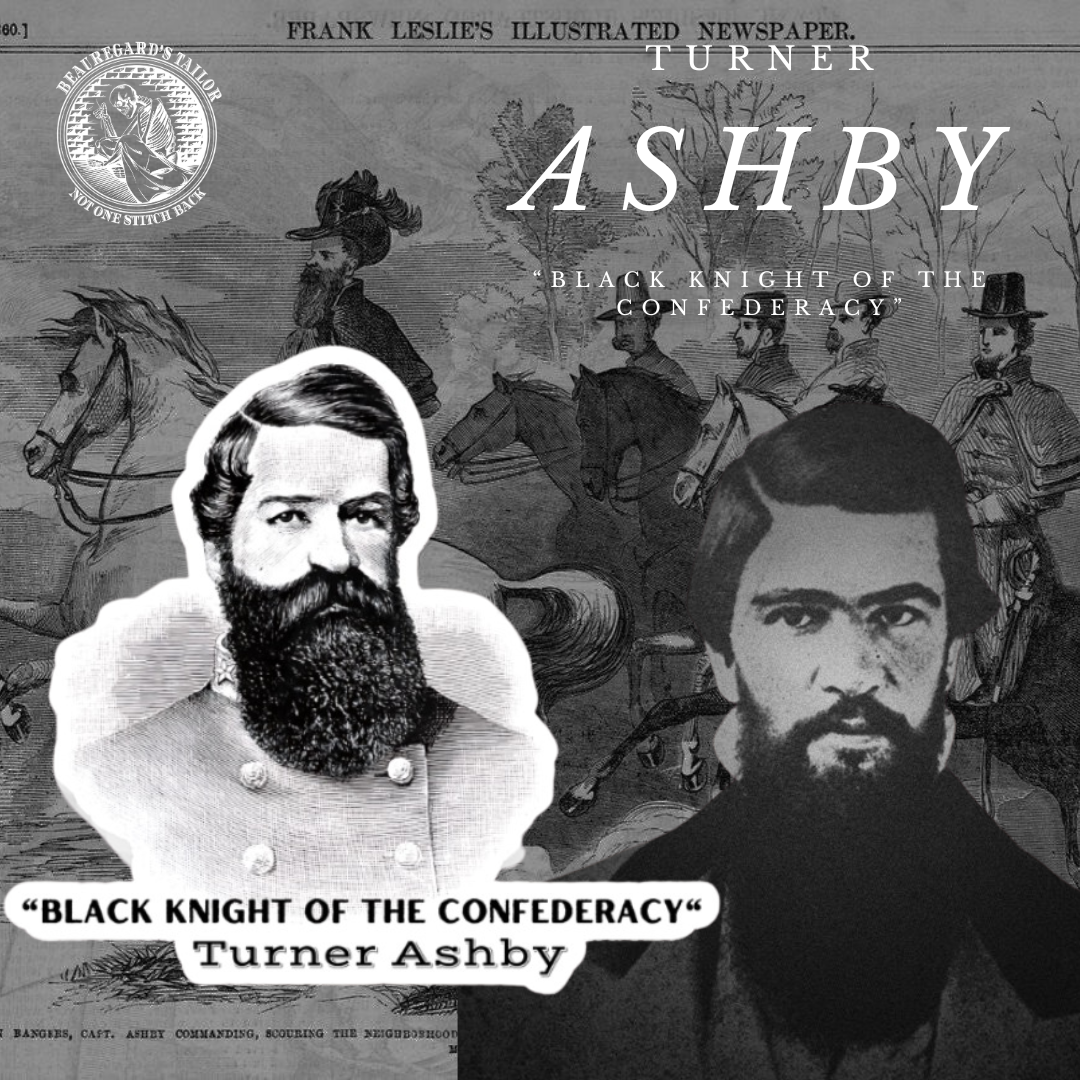Beauregard's Tailor
"Black Knight of the Confederacy" - Turner Ashby Stickers
"Black Knight of the Confederacy" - Turner Ashby Stickers
Couldn't load pickup availability
Historical Background:
At Harpers Ferry, Ashby was assigned to the Virginia Militia command of Colonel Thomas J. “Stonewall” Jackson. He was responsible for guarding fords across the Potomac River and bridges from Harpers Ferry to Point of Rocks, Maryland. His command assisted Maryland men with Confederate sympathies to pass into Virginia, and they disrupted railroad traffic on the Baltimore and Ohio Railroad and interfered with the passage of boats on the Chesapeake and Ohio Canal. Ashby suffered a personal loss when his brother Richard was killed during an engagement with a Union patrol along the Potomac in June 1861. Ashby, convinced of the rumors that his brother had been bayoneted while trying to surrender after he had a chance to examine his corpse, came to hate Northerners and became obsessed with revenge.
On July 23, 1861, Brigadier General Joseph E. Johnston appointed Ashby lieutenant colonel of the 7th Virginia Cavalry. Due to the illness of the regimental commander, Ashby had effective control of half of the regiment, which he operated separately. When the commander retired in February 1862, Ashby assumed command of the entire regiment on March 12. Ashby organized the first Confederate horse artillery, named Chew’s Battery, as part of this regiment. The 7th did not participate directly in the First Battle of Manassas, but Ashby aided the Confederate cause by screening the movement of Johnston’s army to the Manassas area. The Union had hoped that Johnston’s forces would be pinned down by Major General Robert Patterson, but Ashby’s screen allowed Johnston to move freely without Patterson’s interference. In October 1861 he led an attack on Harpers Ferry, a Union armory, but was defeated by Union colonel John W. Geary in what became known as the “Battle of Bolivar Heights”.
By the spring of 1862, the 7th Virginia Cavalry had reached the enormous size of 27 infantry and cavalry companies, much larger than a typical Civil War regiment. Stonewall Jackson, in overall command of the Shenandoah Valley, tried to correct the situation by stripping Ashby of his cavalry forces, ordering them to be assigned to two infantry brigades. Ashby threatened to resign in protest and Jackson backed down. Jackson continued to resist Ashby’s promotion to brigadier general, due to his informal military training and consequent lack of discipline. Nevertheless, Ashby’s promotion came through on May 23, 1862, and he received his promotion and general’s star in a ceremony at the Taylor Hotel in Winchester, Virginia.
Ashby cut a striking figure, called by many the “Black Knight of the Confederacy”. He generally rode horses that were pure white or pure black. A civilian in the Valley named Thomas A. Ashby (no relation) wrote about an encounter with him:
“He was just entering upon a career that soon made him an heroic character in the history of the Civil War. Dressed now in Confederate gray, with gilt lace on his sleeves and collar, wearing high top-boots with spurs and a broad-brimmed black felt hat with a long black feather streaming behind, his appearance was striking and attractive. He stood about five feet eight inches in height and probably weighed from 150 to 160 pounds (68 to 73 kg). He was muscular and wiry, rather thin than robust or rugged. His hair and beard were as black as a raven’s wing; his eyes were soft and mahogany brown; a long, sweeping mustache concealed his mouth, and a heavy and long beard completely covered his breast. His complexion was dark in keeping with his other colorings. Altogether, he resembled the pictures I have seen of the early Crusaders,—a type unusual among the many men in the army, a type so distinctive that, once observed, it cannot soon be forgotten.”
Ashby’s vigorous reconnaissance and screening were factors in the success of Jackson’s legendary Valley Campaign in the Shenandoah Valley in 1862. However, there were instances in which Ashby failed Jackson. At the First Battle of Kernstown, Jackson attacked a retreating Union column that Ashby had estimated to be four regiments of infantry, about the size of Jackson’s force. It turned out to be an entire division of 9,000 men, and Jackson was forced to retreat. At the First Battle of Winchester, as Union forces under Maj. Gen. Nathaniel P. Banks were retreating, Ashby failed to cut off their retreat because his troopers were plundering captured wagons. It is possible that the Union forces could have been substantially destroyed if it were not for this lack of discipline.
As Jackson’s army withdrew from the pressure of Maj. Gen. John C. Frémont’s superior forces, moving from Harrisonburg toward Port Republic, Ashby commanded the rear guard. On June 6, 1862, near Harrisonburg, the 1st New Jersey Cavalry attacked Ashby’s position at Good’s Farm. Although Ashby defeated the cavalry attack, a subsequent infantry engagement resulted in his horse being shot and Ashby charging ahead on foot. Within a few steps, he was shot through the heart, killing him instantly. (The origin of the fatal shot has been lost to history. Soldiers of the 13th Pennsylvania Reserve Infantry, the “Bucktails”, claimed credit, but some accounts blame friendly fire.) His last words were “Charge, men! For God’s sake. Charge!” waving his sword, when a bullet pierced him in the breast and he fell dead.
“Later in the evening I saw a party of cavalry pass by with Ashby’s body, crying, most of them, like children” – Confederate Capt. Campbell Brown
He had been appointed brigadier general just two weeks before his death.
After his death, he was first taken to the Frank Kemper House in Port Republic (today the Port Republic Museum). After the war, he was re-interred with his brother Richard in the Stonewall Confederate Cemetery in Mt. Hebron Cemetery in Winchester, Virginia.
Each purchase comes with three stickers.




